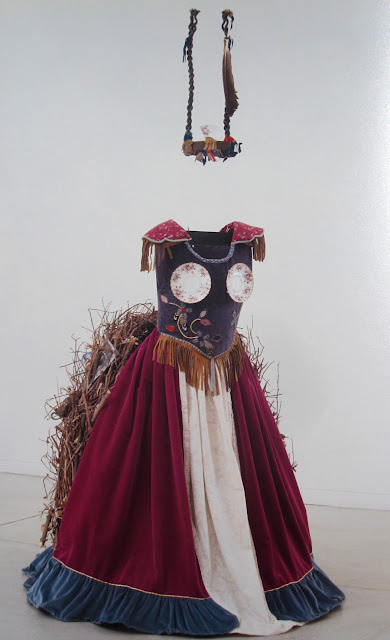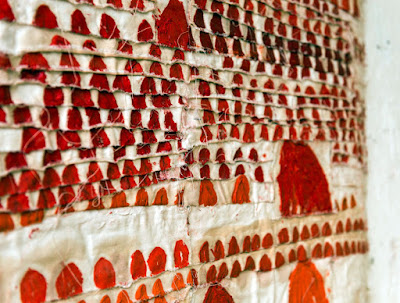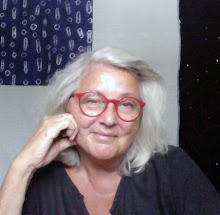 |
| bollenarbeit 244, 2014 oil on canvas 77 x 60" sati zech |
Berlin artist, Sati Zech makes joyful yet meditative artworks that she calls bollenarbeit that refer, she says, to the hills and low mountains of southern Germany, the region where she was born.
 |
| bollenarbeit no 242, 2014 69.5 x 34 inches oil, canvas Sati Zech |
To make them she tears apart sheets of canvas into strips and then reassembles them. Sometimes they are overlapped, sometimes she uses white archival glue, sometimes plaster or wax or thread to put the pieces together. The domes and dots of thick red paint are placed in horizontals on the cloth surfaces before or sometimes after this assembling.
 |
| bollenarbeit no 19, 2006 oil, canvas 94 x 63 inches, Sati Zech |
In 2006 she had an exhibition of this body of work at the Heidelberger Kunstverein in Germany, and has gone on to show variations on the theme around the world. Her New York gallery, the Howard Scott has this to say about Sati Zech's bollen paintings.
"The artworks of Sati Zech are unique amalgams of historically ritualistic mark making and 21st century self-expression. They emanate feelings of femaleness: her power and passion, her cycles and repetitions."
 |
| bollenarbeit 110, 2010 37.5 x 27 inches, oil, canvas, wax, Sati Zech |
"The layering, gluing, tearing, sewing all give rise to the idea of labour. Specifically women's labour, a kind of thoughtful, painstaking never-ending work that manifests itself in tactile visions of strength, beauty, necessity, serendipity."
"They contain the emotional dynamism of Louise Bourgois, the semantic materiality of Joseph Beuys, the subtle tactility of Eva Hesse and the symbolic charge of African art." all quotes from
Howard Scott Gallery
 |
| Sati Zech's studio with her dog, Rudi |
Why does this work resonate so much?
Is it the colour?
red .... white
Or the repetition of rounded shape
Or the variety within that repetition
like natural elements - like human figures
Or the emotion expressed with the tearing up of the cloth
and the made elements
the destruction?
Or is it the hand-made de-skilled repairing of that cloth?
Is it because the artist has created a new square
a new human scaled rectangle
fabric that looks to be careless,
but that has taken much thought and care.
much work
There is a feeling of safety in these pieces.
"These works are about communication. The single bollen are like elements of a piece of music, or flags, or skin that's been branded." Sati Zech
 |
| for Louise Bourgois #17 Sati Zech bollenarbeit detail |
She is inspired by the large sensual traditional artforms of several African countries.
 |
| for Louise Bourgois #18 Sati Zech bollenarbeit detail |
She is inspired by female sensibility.
All information is from the internet. Click
here for Howard Scott gallery,
here for an image-full Zeit visit with the artist and
here for Sati Zech's own website.
Sati Zech speaks about destroying and re-building and about the power and rhythm of communication
on this video from Paris.















































